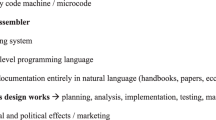Abstract
This review of Turner’s “Computational Artifacts” focuses on one of the key novelties of the book, namely the proposal to understand the nature of computer programs as a “trinity” of specification, symbolic program, and physical process, replacing the traditional dualist views of programs as functional/structural or as symbolic/physical. This trinitarian view is found to be robust and helpful to solve typical issues of dualist views. Drawing comparisons with Simon’s view of the artifact as an interface, the author suggests that this trinitarian view may characterize not only computational artifacts but also artifacts in general. One ambiguity is however noticed on the denotation of what Turner actually calls the “physical process.”
Similar content being viewed by others
Notes
Kroes refers explicitly to the mind-body problem regarding his dualism (Kroes 2010, p. 56), while in the case of the dualist view of computer programs, Colburn ((Colburn 2000, p. 208) quoted by Turner 2018, p. 51) mentions a “pre-established harmony”—referring to the well-known solution by Leibniz to the mind-body problem.
“The logic of heuristic decision making” published in 1967 (two years prior to the Sciences of the Artificial) and reprinted as part of Simon (1977). To our knowledge, it is the first mention of the artifact as an interface in Simon’s publications.
References
Colburn, T. (2000). Philosophy and computer science (1st ed.). Armonk: M.E. Sharpe.
Kroes, P. (2010). Engineering and the dual nature of technical artefacts. Cambridge Journal of Economics, 34(1), 51–62. https://doi.org/10.1093/cje/bep019.
Kroes, P. (2012). Technical artefacts: creations of mind and matter: a philosophy of engineering design. In Philosophy of engineering and technology 6. Dordrecht: Springer.
Moor, J. H. (1978). Three myths of computer science. The British Journal for the Philosophy of Science, 29(3), 213–222.
Simon, H. A. (1977). Models of discovery: and other topics in the methods of science. In Boston studies in the philosophy of science (Vol. 54). Dordrecht: Boston: D. Reidel Pub. Co.
Turner, R. (2018). Computational artifacts: towards a philosophy of computer science. Berlin Heidelberg New York: Springer.
Author information
Authors and Affiliations
Corresponding author
Additional information
Publisher’s Note
Springer Nature remains neutral with regard to jurisdictional claims in published maps and institutional affiliations.
Rights and permissions
About this article
Cite this article
Stephanou, H. About the “Trinity Thesis” Regarding the Ontology of Computer Programs. Philos. Technol. 33, 323–330 (2020). https://doi.org/10.1007/s13347-019-00368-5
Received:
Accepted:
Published:
Issue Date:
DOI: https://doi.org/10.1007/s13347-019-00368-5




